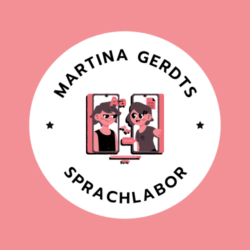
Social Media brings some gems into the world. French teacher Anne from “Myfrenchatelier” on Instagram posted a few days ago about how to flirt with French energy (“Flirting in French”). That made me wonder: How do you flirt in a language you are still learning?
Dating 101 for language beginners
If you are just starting out to learn a language, it’s easy to get better in the realm of flirting. You start with introducing yourself and asking the other person about themselves. You learn to ask if you want to meet somewhere, and you start discussing activities for a meet up. You can create your very own “dating 101” words and phrases out of beginner material very fast.
Task 1: What are typical activities for a date for you? How are those activities called in your target language?
Vocabulary around your own interests
After learning the basics, you can think about what else you might need. What about being able to state what you are looking for or how to say phrases you would use while flirting in your other language(s)? Material around how to say “I love you” or “you look pretty in that suit” might be of interest for you.
ELE teacher Sol Tovar has created a page of material for Spanish learners with some words around San Valentín, check it out here: “Material ELE: San Valentín” (in Spanish).
Task 2: Think about some more phrases you would like to be able to say in your target language that might come handy for flirting situations.
But how do you flirt in ANY LANGUAGE?!
Flirting is a very individual thing. Everyone flirts a little different (if they are flirting at all). But we can have a look at some ways, how some people flirt:
- Use humor (that translates so well in other languages *throws the irony sign at the statement*)
- Behave like a nice and kind person (that could also just be a sign of a genuinely kind person doing what they do on a daily basis)
- Give out compliments (you have to decide which compliments are appropriate in your context and which ones work best with a certain person; Does the person like compliments about their new jumper or do they prefer compliments about their work as an author or about their hobbies?)
- Show an interest in the other person’s interests (Have you ever told an academic that you have read their thesis without having had to do so? This can work like magic!)
There are way more ways how people flirt. It’s also seen as flirting if someone does whatever they have to do to get some attention of their person of interest or even if they are insulting their person of interest. Please keep in mind that just because you don’t mean any harm, it doesn’t always mean you are not harming anyone. It goes similarly the other way around: Just because they say they don’t mean any harm; you can still feel hurt and disrespected.
Task 3: Think about different ways of how people flirt and what feels most fitting for yourself. What kind of words and phrases do you need for that?
Flirting or being genuinely nice or just chatter-loving, which one is this?
What’s read as flirting differs highly from person to person. There are cultural factors, factors of age, gender, social groups; former experiences play a role as much as many other things. Some people need an “I am flirting with you” (very on the nose) to realize what’s happening.
Let’s take the Northern German cliché for a second. People say that it’s enough to greet people in Northern Germany with “Moin” (‘hello/ morning’) instead of saying “Moin moin” because the latter is seen as chattering. People also say “jo” (‘yes/ yeah’) can be a whole conversation in Northern Germany. Imagine how flirting with a person of very few words might look like in contrast to flirting with a chatter-loving person. But be aware, you could also run into a chatter-loving Northern German person! 😀
Well, yeah, I know. But how do I know then?
I’m sorry, that’s your task to figure out <3
I’m just here to support your language learning progress. 🙂
Task 4: Take action! (And stay accountable with your actions!)
References:
Anne @myfrenchatelier, Instagram account, https://www.instagram.com/myfrenchatelier (Link last checked: May 17th, 2025).
Anne @myfrenchatelier: „Flirting in French“, Instagram post, https://www.instagram.com/p/DJR1YzDowLQ/?img_index=1 (Link last checked: May 17th, 2025).
Tovar, Sol (2020): „Material ELE: San Valentín“, in: Sol Tovar: Languages & Communication, https://www.soltov.ar/2020/09/material-ele-san-valentin.html (Link last checked: May 17th).

